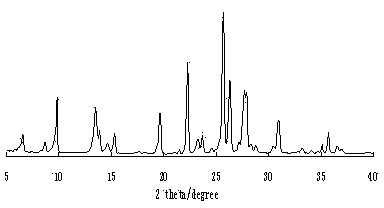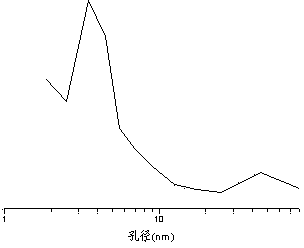Preparation method of mesopore-micropore zeolite molecular sieve
A technology of microporous zeolite and molecular sieve, applied in the direction of crystalline aluminosilicate zeolite, etc., can solve the problems of reducing the catalytic activity of zeolite, low micropore surface area, damage to the micropore crystal structure, etc., and achieve the effect of improving the BET surface area.
- Summary
- Abstract
- Description
- Claims
- Application Information
AI Technical Summary
Problems solved by technology
Method used
Image
Examples
Embodiment 1
[0037] Take 30g of microporous mordenite and 2400mL of 0.30 mol / L NaOH solution in a beaker, place it in an ultrasonic cleaner (4.12W / 100mL alkali solution, 40KHz), add mechanical stirring, and ultrasonically treat for 30min; then transfer to a closed reaction In the still, add 75mL of methanol, treat at 60°C for 4h, filter and wash. Put the washed mordenite in a beaker, add 1500mL of 0.2mol / L hydrochloric acid solution, stir at room temperature for 20min, transfer to a water bath at 70°C for 3h, filter, wash, and dry in an oven at 110°C for 12h , and the obtained sample number is CL1.
[0038] Depend on figure 1 It can be seen that the CL1 sample has the characteristic spectrum of mordenite and still maintains a good zeolite structure. Depend on image 3 It can be seen that after the modification treatment, there is an obvious concentration of mesopores in the microporous mordenite, and the most probable pore diameter is 3.5nm, indicating that after the treatment, a large ...
Embodiment 2
[0040] Take 30 g of microporous ZSM-5 zeolite and 1200 mL of 0.60 mol / L KOH solution in a beaker, place it in an ultrasonic cleaner (12.5W / 100mL alkali solution, 25KHz), add mechanical stirring, and ultrasonicate for 20 minutes; Stir at low temperature for 30min, transfer to a closed reaction kettle, add 90mL of ethanol, treat at 80°C for 3h, filter and wash. Put the washed ZSM-5 zeolite in a beaker, add 900mL of 0.2mol / L nitric acid solution, stir at room temperature for 20min, transfer to a water bath at 90°C for 2h, filter, wash, and place in an oven at 110°C After drying for 12 hours, the obtained sample number is CL2.
Embodiment 3
[0042] Take 30 g of microporous β, 0.50 mol / L NaOH solution 2100mL in a beaker, put it in an ultrasonic cleaner (4.76W / 100mL alkali solution, 45KHz), add mechanical stirring, ultrasonic treatment for 40min; then transfer to a closed reaction Add 50mL of propanol to the kettle, and treat it at 100°C for 4h; filter and wash; put the washed zeolite beta into a beaker, add 1500mL of 0.8mol / L sulfuric acid solution, stir at room temperature for 30min, transfer to Treat in a water bath at 90°C for 3h, filter, wash, and then dry in an oven at 110°C for 12h. The obtained sample number is CL3.
[0043] Depend on figure 2 It can be seen that the CL3 sample has the characteristic spectrum of zeolite beta and still maintains a good structure of zeolite beta. Depend on Figure 4 It can be seen that after the modification treatment, there is an obvious concentration of mesoporous pore diameters in the microporous zeolite β, and the most probable pore diameter is 3.5 nm.
PUM
| Property | Measurement | Unit |
|---|---|---|
| specific surface area | aaaaa | aaaaa |
| specific surface area | aaaaa | aaaaa |
| specific surface area | aaaaa | aaaaa |
Abstract
Description
Claims
Application Information
 Login to View More
Login to View More - R&D
- Intellectual Property
- Life Sciences
- Materials
- Tech Scout
- Unparalleled Data Quality
- Higher Quality Content
- 60% Fewer Hallucinations
Browse by: Latest US Patents, China's latest patents, Technical Efficacy Thesaurus, Application Domain, Technology Topic, Popular Technical Reports.
© 2025 PatSnap. All rights reserved.Legal|Privacy policy|Modern Slavery Act Transparency Statement|Sitemap|About US| Contact US: help@patsnap.com



